Hybrid Computation of the Aerodynamic Noise Radiated by the Wake of a Subsonic Cylinder
Abstract
:1. Introduction
2. Case Definition and Methodology
2.1. Mathematical Model
2.2. Numerical Method
2.3. Far-Field Noise Prediction
2.4. Dynamic Mode Decomposition (DMD)
3. Results
3.1. Flow Field Validation
3.2. Noise Field Results
4. Summary
Author Contributions
Funding
Data Availability Statement
Conflicts of Interest
References
- Hanning, C.D.; Evans, A.D. Wind turbine noise. BMJ Br. Med. J. 2012, 344. [Google Scholar] [CrossRef] [PubMed]
- Van den Berg, F. Wind turbine noise: An overview of acoustical performance and effects on residents. Proc. Acoust. 2013. Available online: http://docs.wind-watch.org/AAS-2013-p108-van-den-Berg.pdf (accessed on 1 February 2022).
- Deshmukh, S.; Bhattacharya, S.; Jain, A.; Paul, A.R. Wind turbine noise and its mitigation techniques: A review. Energy Procedia 2019, 160, 633–644. [Google Scholar] [CrossRef]
- Fritschi, L.; Brown, L.; Kim, R.; Schwela, D.H.; Kephalopolous, S. Burden of Disease from Environmental Noise: Quantification of Healthy Life Years Lost in Europe; World Health Organization: Geneva, Switzerland, 2011. [Google Scholar]
- Eriksson, C.; Pershagen, G.; Nilsson, M. Biological Mechanisms Related to Cardiovascular and Metabolic Effects by Environmental Noise; Technical Documents; WHO: Geneva, Switzerland, 2018; Volume 3, p. 13. [Google Scholar]
- Knörzer, D.; Szodruch, J. (Eds.) Flightpath 2050: Europe’s vision for aeronautics. In Innovation for Sustainable Aviation in a Global Environment: Proceedings of the Sixth European Aeronautics Days, Madrid; IOS Press: Amsterdam, The Netherlands, 2012; Volume 30. [Google Scholar]
- Xiao-Ming, T.; Zhi-Gang, Y.; Xi-Ming, T.; Xiao-Long, W.; Jie, Z. Vortex structures and aeroacoustic performance of the flow field of the pantograph. J. Sound Vib. 2018, 432, 17–32. [Google Scholar] [CrossRef]
- Zhang, Y.; Zhang, J.; Li, T.; Zhang, L. Investigation of the aeroacoustic behavior and aerodynamic noise of a high-speed train pantograph. Sci. China Technol. Sci. 2017, 60, 561–575. [Google Scholar] [CrossRef]
- Ikeda, M.; Mitsumoji, T. Evaluation method of low-frequency aeroacoustic noise source structure generated by Shinkansen pantograph. Q. Rep. RTRI 2008, 49, 184–190. [Google Scholar] [CrossRef]
- Keating, A.; Dethioux, P.; Satti, R.; Noelting, S.; Louis, J.; Van de Ven, T.; Vieito, R. Computational aeroacoustics validation and analysis of a nose landing gear. In Proceedings of the 15th AIAA/CEAS Aeroacoustics Conference (30th AIAA Aeroacoustics Conference), Miami, FL, USA, 11–13 May 2009; p. 3154. [Google Scholar]
- Lockard, D.; Khorrami, M.; Li, F. Aeroacoustic analysis of a simplified landing gear. In Proceedings of the 9th AIAA/CEAS Aeroacoustics Conference and Exhibit, Hilton Head, SC, USA, 12–14 May 2003; p. 3111. [Google Scholar]
- Redonnet, S.; Khelil, S.B.; Bulté, J.; Cunha, G. Numerical characterization of landing gear aeroacoustics using advanced simulation and analysis techniques. J. Sound Vib. 2017, 403, 214–233. [Google Scholar] [CrossRef]
- Williamson, C.H. Vortex dynamics in the cylinder wake. Annu. Rev. Fluid Mech. 1996, 28, 477–539. [Google Scholar] [CrossRef]
- Leehey, P.; Hanson, C. Aeolian tones associated with resonant vibration. J. Sound Vib. 1970, 13, 465–483. [Google Scholar] [CrossRef]
- Curle, N. The influence of solid boundaries upon aerodynamic sound. In Proceedings of the Royal Society of London. Series A. Mathematical and Physical Sciences; The Royal Society: London, UK, 1995; Volume 231, pp. 505–514. [Google Scholar]
- Phillips, O.M. The intensity of Aeolian tones. J. Fluid Mech. 1956, 1, 607–624. [Google Scholar] [CrossRef]
- Etkin, B.; Korbacher, G.K.; Keefe, R.T. Acoustic Radiation from a Stationary Cylinder in a Fluid Stream (Aeolian Tones). J. Acoust. Soc. Am. 1957, 29, 30–36. [Google Scholar] [CrossRef]
- Wagner, C.; Hüttl, T.; Sagaut, P. Large-Eddy Simulation for Acoustics; Cambridge Aerospace Series; Cambridge University Press: Cambridge, UK, 2007; Volume 20. [Google Scholar] [CrossRef]
- Lighthill, M.J. On sound generated aerodynamically I. General theory. Proc. R. Soc. London Ser. A Math. Phys. Sci. 1952, 211, 564–587. [Google Scholar]
- Williams, J.F.; Hawkings, D.L. Sound generation by turbulence and surfaces in arbitrary motion. In Philosophical Transactions for the Royal Society of London. Series A Mathematical and Physical Sciences; The Royal Society: London, UK, 1969; pp. 321–342. [Google Scholar]
- Brentner, K.S.; Farassat, F. Modeling aerodynamically generated sound of helicopter rotors. Prog. Aerosp. Sci. 2003, 39, 83–120. [Google Scholar] [CrossRef]
- Cianferra, M.; Ianniello, S.; Armenio, V. Assessment of methodologies for the solution of the Ffowcs Williams and Hawkings equation using LES of incompressible single-phase flow around a finite-size square cylinder. J. Sound Vib. 2019, 453, 1–24. [Google Scholar] [CrossRef]
- Yao, H.D.; Davidson, L.; Eriksson, L.E. Noise radiated by low-Reynolds number flows past a hemisphere at Ma = 0.3. Phys. Fluids 2017, 29, 076102. [Google Scholar] [CrossRef]
- Khalighi, Y.; Mani, A.; Ham, F.; Moin, P. Prediction of Sound Generated by Complex Flows at Low Mach Numbers. AIAA J. 2010, 48, 306–316. [Google Scholar] [CrossRef]
- Cai, J.C.; Pan, J.; Kryzhanovskyi, A.; E, S.J. A numerical study of transient flow around a cylinder and aerodynamic sound radiation. Thermophys. Aeromechanics 2018, 25, 331–346. [Google Scholar] [CrossRef]
- Alhawwary, M.; Wang, Z. Implementation of a FWH approach in a high-order LES tool for aeroacoustic noise predictions. In AIAA Scitech 2020 Forum; American Institute of Aeronautics and Astronautics: Reston, VA, USA, 2020; Volume 1. [Google Scholar] [CrossRef]
- Shur, M.L.; Spalart, P.R.; Strelets, M.K. Noise prediction for increasingly complex jets. Part II: Applications. Int. J. Aeroacoustics 2005, 4, 247–266. [Google Scholar] [CrossRef]
- Morris, P.J.; Long, L.N.; Scheidegger, T.E.; Boluriaan, S. Simulations of Supersonic Jet Noise. Int. J. Aeroacoustics 2002, 1, 17–41. [Google Scholar] [CrossRef]
- Uzun, A.; Lyrintzis, A.S.; Blaisdell, G.A. Coupling of Integral Acoustics Methods with LES for Jet Noise Prediction. Int. J. Aeroacoustics 2004, 3, 297–346. [Google Scholar] [CrossRef]
- Moreau, S. The third golden age of aeroacoustics. Phys. Fluids 2022, 34, 031301. [Google Scholar] [CrossRef]
- Cox, J.S.; Brentner, K.S.; Rumsey, C.L. Computation of vortex shedding and radiated sound for a circular cylinder: Subcritical to transcritical Reynolds numbers. Theor. Comput. Fluid Dyn. 1998, 12, 233–253. [Google Scholar] [CrossRef]
- Liu, X.; Thompson, D.J.; Hu, Z. Numerical investigation of aerodynamic noise generated by circular cylinders in cross-flow at Reynolds numbers in the upper subcritical and critical regimes. Int. J. Aeroacoustics 2019, 18, 470–495. [Google Scholar] [CrossRef]
- Orselli, R.; Meneghini, J.; Saltara, F. Two and three-dimensional simulation of sound generated by flow around a circular cylinder. In Proceedings of the 15th AIAA/CEAS Aeroacoustics Conference (30th AIAA Aeroacoustics Conference), Miami, FL, USA, 11–13 May 2009; p. 3270. [Google Scholar]
- Iglesias, E.L.; Thompson, D.; Smith, M. Experimental study of the aerodynamic noise radiated by cylinders with different cross-sections and yaw angles. J. Sound Vib. 2016, 361, 108–129. [Google Scholar] [CrossRef]
- Margnat, F.; da Silva Pinto, W.J.G.; Noûs, C. Cylinder aeroacoustics: Experimental study of the influence of cross-section shape on spanwise coherence length. Acta Acust. 2023, 7, 4. [Google Scholar] [CrossRef]
- Sueki, T.; Ikeda, M.; Takaishi, T. Aerodynamic noise reduction using porous materials and their application to high-speed pantographs. Q. Rep. RTRI 2009, 50, 26–31. [Google Scholar] [CrossRef]
- Geyer, T.F.; Sarradj, E. Circular cylinders with soft porous cover for flow noise reduction. Exp. Fluids 2016, 57, 30. [Google Scholar] [CrossRef]
- Yu, P.; Xu, J.; Xiao, H.; Bai, J. Numerical Analysis of Aeroacoustic Characteristics around a Cylinder under Constant Amplitude Oscillation. Energies 2022, 15, 6507. [Google Scholar] [CrossRef]
- Inoue, O.; Hatakeyama, N. Sound generation by a two-dimensional circular cylinder in a uniform flow. J. Fluid Mech. 2002, 471, 285–314. [Google Scholar] [CrossRef]
- King, W.; Pfizenmaier, E. An experimental study of sound generated by flows around cylinders of different cross-section. J. Sound Vib. 2009, 328, 318–337. [Google Scholar] [CrossRef]
- Schmid, P.J. Dynamic mode decomposition of numerical and experimental data. J. Fluid Mech. 2010, 656, 5–28. [Google Scholar] [CrossRef]
- Favre, A.J. The Equations of Compressible Turbulent Gases. In Technical Report AD622097; Institut de Mecanique Statlstique de la Turbulence: Marseille, France, 1965. [Google Scholar]
- Lehmkuhl, O.; Piomelli, U.; Houzeaux, G. On the extension of the integral length-scale approximation model to complex geometries. Int. J. Heat Fluid Flow 2019, 78, 108422. [Google Scholar] [CrossRef]
- Rouhi, A.; Piomelli, U.; Geurts, B.J. Dynamic subfilter-scale stress model for large-eddy simulations. Phys. Rev. Fluids 2016, 1, 044401. [Google Scholar] [CrossRef]
- Piomelli, U.; Rouhi, A.; Geurts, B.J. A grid-independent length scale for large-eddy simulations. J. Fluid Mech. 2015, 766, 499–527. [Google Scholar] [CrossRef]
- Huang, P.; Coleman, G.; Bradshaw, P. Compressible turbulent channel flows: DNS results and modelling. J. Fluid Mech. 1995, 305, 185–218. [Google Scholar] [CrossRef]
- Gasparino, L.; Muela, J.; Lehmkuhl, O. SOD2D Repository. Available online: https://gitlab.com/bsc_sod2d/sod2d_gitlab (accessed on 1 February 2022).
- Guermond, J.L.; Pasquetti, R.; Popov, B. Entropy viscosity method for nonlinear conservation laws. J. Comput. Phys. 2011, 230, 4248–4267. [Google Scholar] [CrossRef]
- Kennedy, C.A.; Gruber, A. Reduced aliasing formulations of the convective terms within the Navier–Stokes equations for a compressible fluid. J. Comput. Phys. 2008, 227, 1676–1700. [Google Scholar] [CrossRef]
- Wasistho, B.; Geurts, B.J.; Kuerten, J.G. Simulation techniques for spatially evolving instabilities in compressible flow over a flat plate. Comput. Fluids 1997, 26, 713–739. [Google Scholar] [CrossRef]
- Pope, S.B. Turbulent Flows; Cambridge University Press: Cambridge, MA, USA, 2000; Chapter 6. [Google Scholar]
- Barros-Neto, J. An Introduction to the Theory of Distributions; M. Dekker: Weston, CT, USA, 1973; Volume 14. [Google Scholar]
- Wolf, W.R.; Azevedo, J.L.F.; Lele, S.K. Convective effects and the role of quadrupole sources for aerofoil aeroacoustics. J. Fluid Mech. 2012, 708, 502–538. [Google Scholar] [CrossRef]
- Wolf, W.R.; Cavalieri, A.V.G.; Backes, B.; Morsch-Flho, E.; Azevedo, J.L. Sound and Sources of Sound in a Model Problem with Wake Interaction. AIAA J. 2015, 53, 2588–2606. [Google Scholar] [CrossRef]
- Di Francescantonio, P. A new boundary integral formulation for the prediction of sound radiation. J. Sound Vib. 1997, 202, 491–509. [Google Scholar] [CrossRef]
- Najafi-Yazdi, A.; Brès, G.A.; Mongeau, L. An acoustic analogy formulation for moving sources in uniformly moving media. Proc. R. Soc. A Math. Phys. Eng. Sci. 2011, 467, 144–165. [Google Scholar] [CrossRef]
- Zhou, Z.; Wang, H.; Wang, S.; He, G. Lighthill stress flux model for Ffowcs Williams–Hawkings integrals in frequency domain. AIAA J. 2021, 59, 4809–4814. [Google Scholar] [CrossRef]
- Mitchell, B.E.; Lele, S.K.; Moin, P. Direct computation of the sound generated by vortex pairing in an axisymmetric jet. J. Fluid Mech. 1999, 383, 113–142. [Google Scholar] [CrossRef]
- Ricciardi, T.R.; Wolf, W.R.; Spalart, P.R. On the Application of Incomplete Ffowcs Williams and Hawkings Surfaces for Aeroacoustic Predictions. AIAA J. 2022, 60, 1971–1977. [Google Scholar] [CrossRef]
- Tu, J.H. Dynamic Mode Decomposition: Theory and Applications. Ph.D. Thesis, Princeton University, Princeton, NJ, USA, 2013. [Google Scholar]
- Jovanović, M.R.; Schmid, P.J.; Nichols, J.W. Sparsity-promoting dynamic mode decomposition. Phys. Fluids 2014, 26. [Google Scholar] [CrossRef]
- Norberg, C. Fluctuating lift on a circular cylinder: Review and new measurements. J. Fluids Struct. 2003, 17, 57–96. [Google Scholar] [CrossRef]
- Dong, S.; Karniadakis, G.E. DNS of flow past a stationary and oscillating cylinder at Re = 10,000. J. Fluids Struct. 2005, 20, 519–531. [Google Scholar] [CrossRef]
- Prsic, M.A.; Ong, M.C.; Pettersen, B.; Myrhaug, D. Large Eddy Simulations of flow around a smooth circular cylinder in a uniform current in the subcritical flow regime. Ocean. Eng. 2014, 77, 61–73. [Google Scholar] [CrossRef]
- Gowen, F.E.; Perkins, E.W. Drag of circular cylinders for a wide range of Reynolds numbers and Mach numbers. In Technical Report NACA RM A52C20; NASA: Washington, DC, USA, 1952. [Google Scholar]
- Welsh, C.J. The Drag of Finite-Length Cylinders Determined from Flight Tests at High Reynolds Numbers for a Mach Number Range from 0.5 to 1.3. In Technical Report NACA TN 2941; NASA: Washington, DC, USA, 1953. [Google Scholar]
- Murthy, V.; Rose, W. Detailed measurements on a circular cylinder in cross flow. AIAA J. 1978, 16, 549–550. [Google Scholar] [CrossRef]
- Wieselsberger, C. New data on the laws of fluid resistance. In Technical Report NACA TN84; NASA: Washington, DC, USA, 1922. [Google Scholar]
- Gopalkrishnan, R. Vortex-Induced Forces on Oscillating Bluff Cylinders, Technical Report 12539. Ph.D. Thesis, Massachusetts Institute of Technology, Cambridge, MA, USA, 1993. [Google Scholar]
- Norberg, C. LDV-measurements in the near wake of a circular cylinder. In ASME Paper No. FEDSM98-521; Lund Institute of Technology: Lund, Sweden, 1998; Volume 41. [Google Scholar]
- Rodriguez, O. The circular cylinder in subsonic and transonic flow. AIAA J. 1984, 22, 1713–1718. [Google Scholar] [CrossRef]
- Prasad, A.; Williamson, C.H. The instability of the separated shear layer from a bluff body. Phys. Fluids 1996, 8, 1347–1349. [Google Scholar] [CrossRef]
- Jeong, J.; Hussain, F. On the identification of a vortex. J. Fluid Mech. 1995, 285, 69–94. [Google Scholar] [CrossRef]
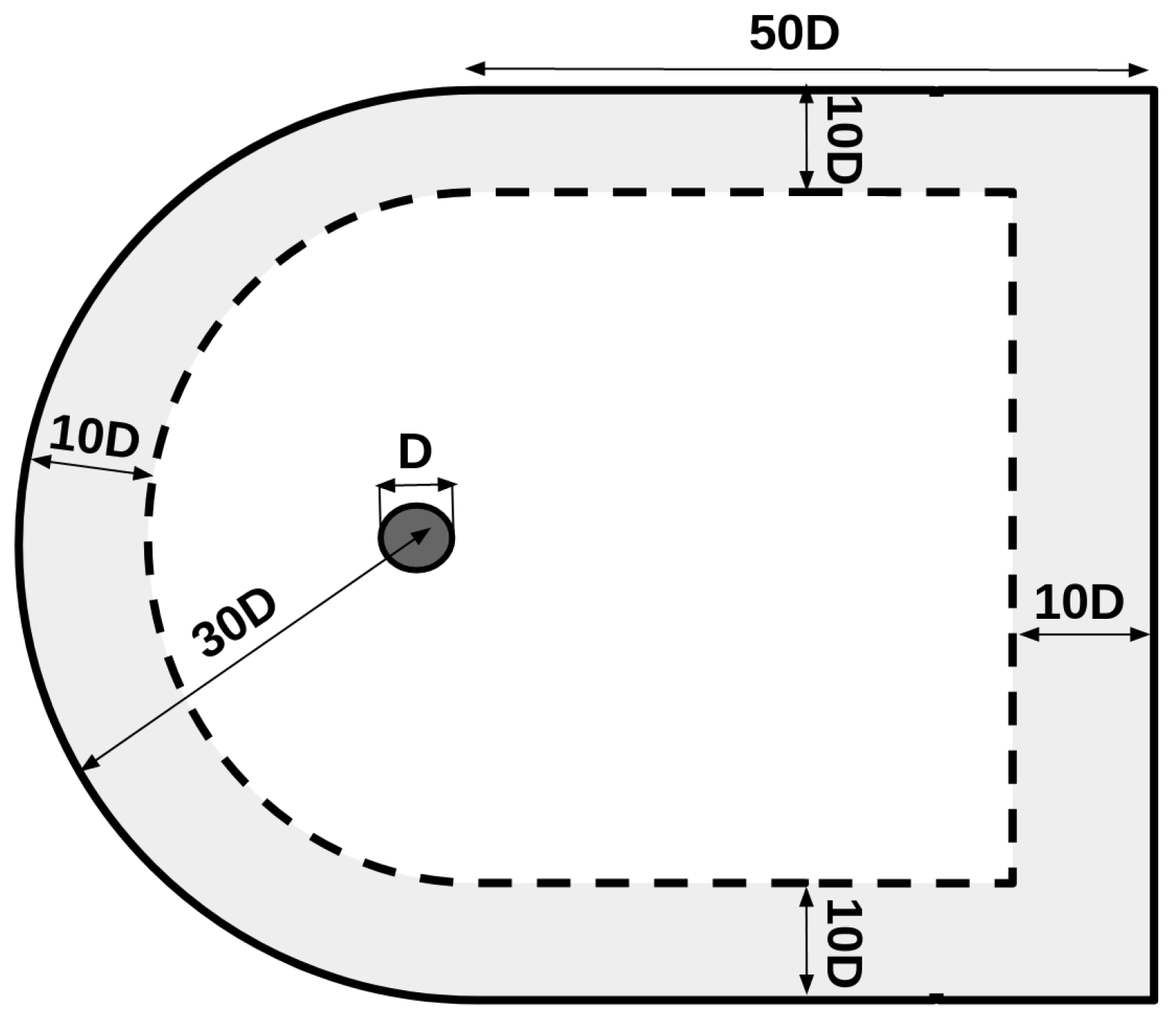



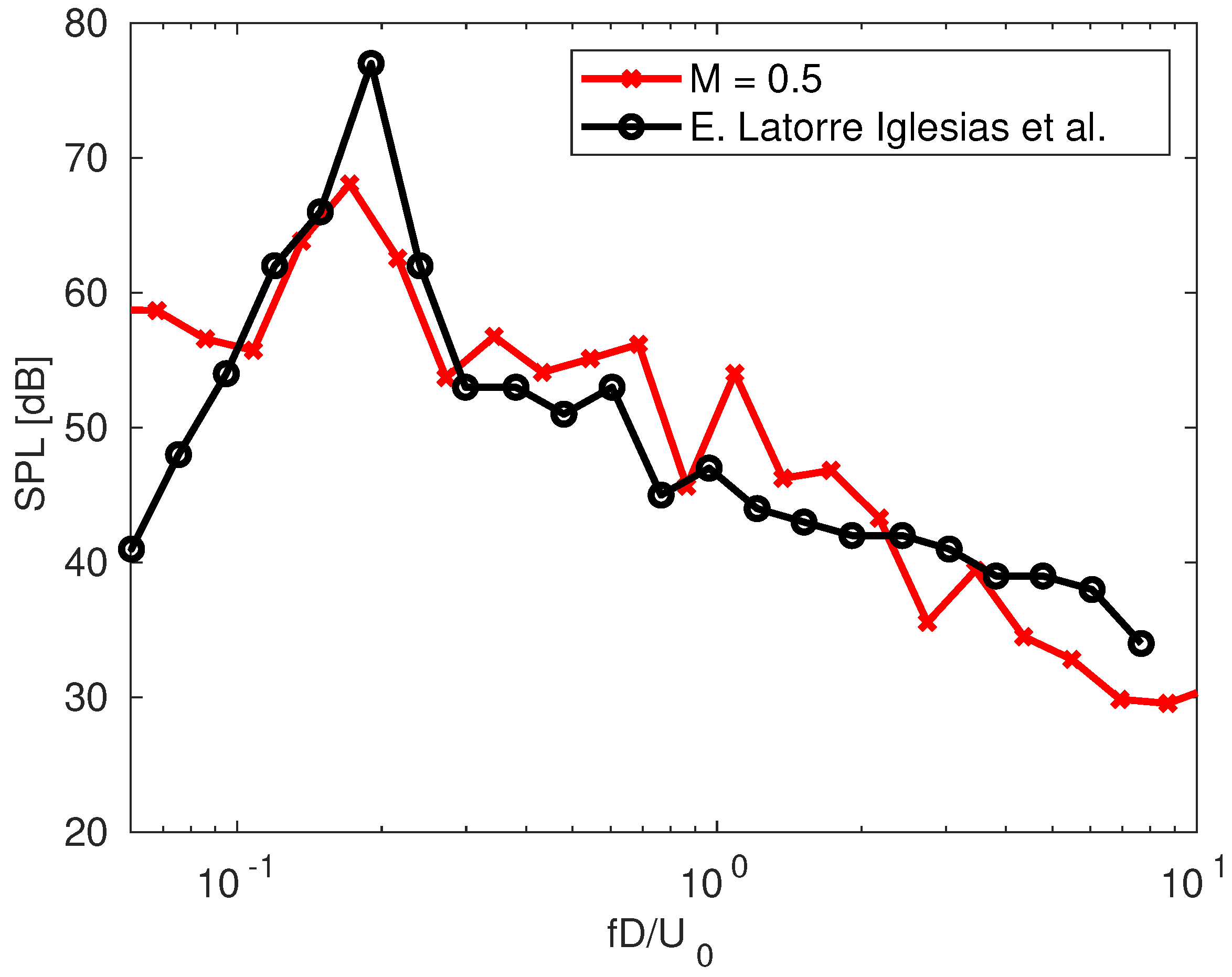




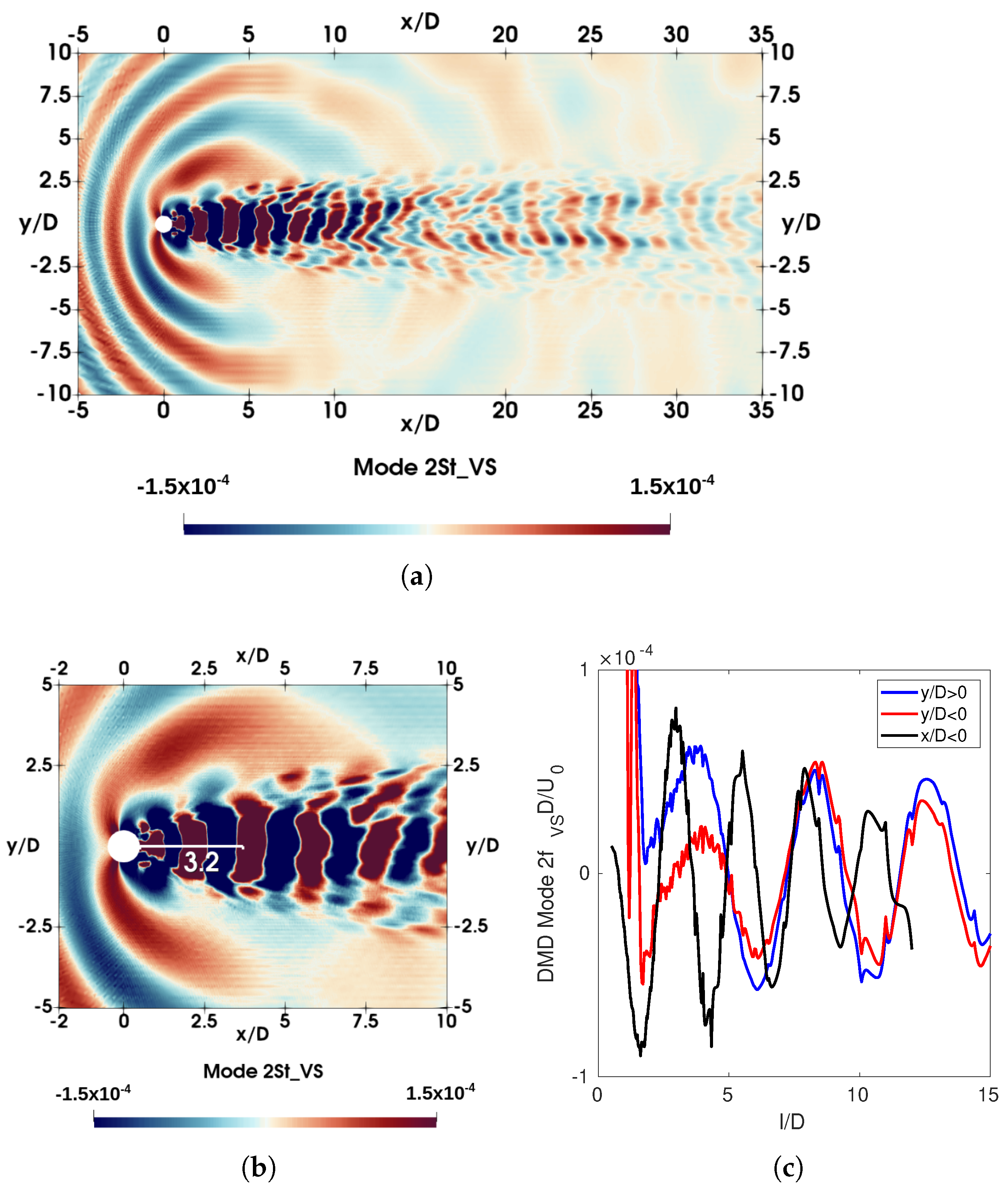

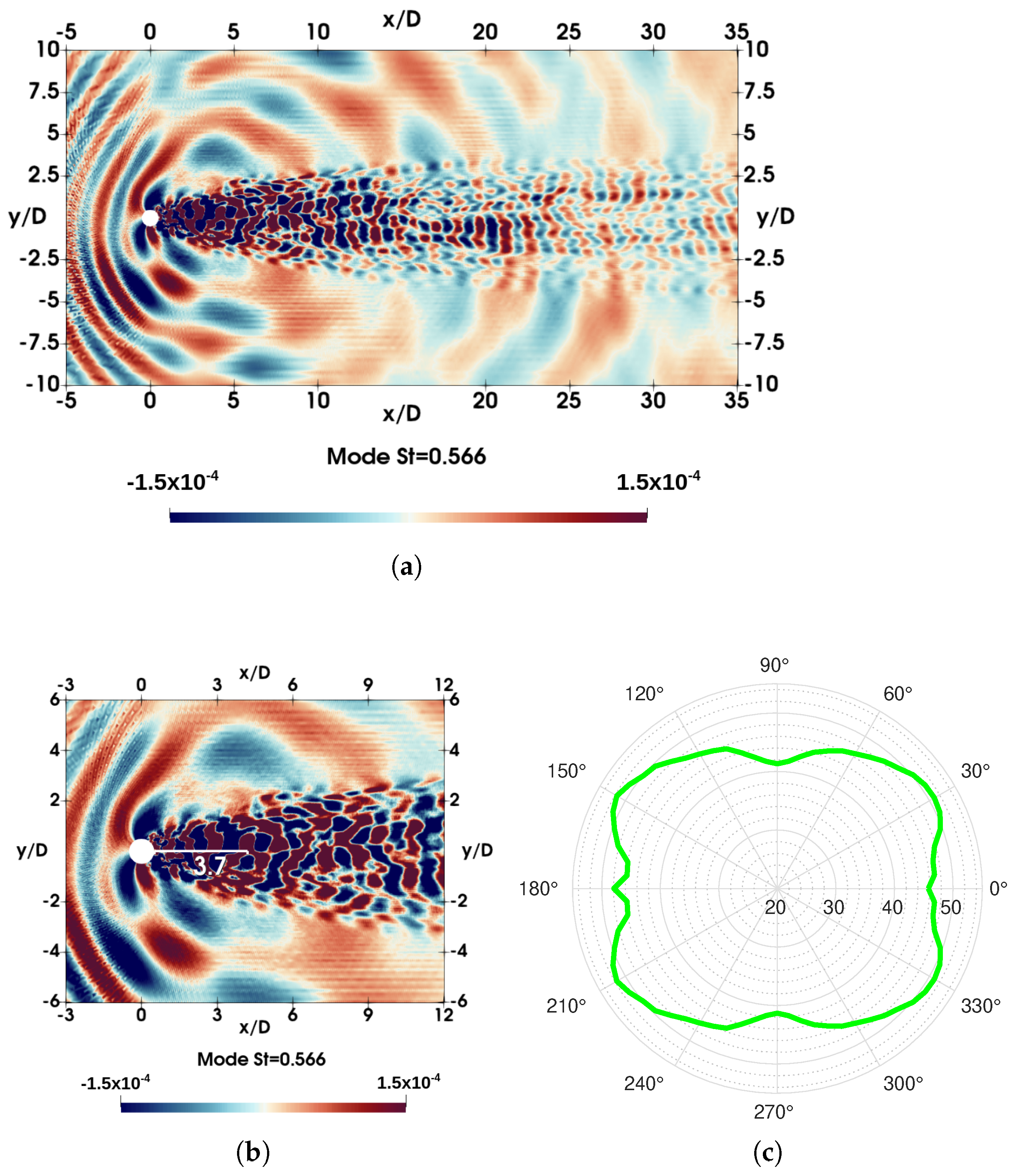

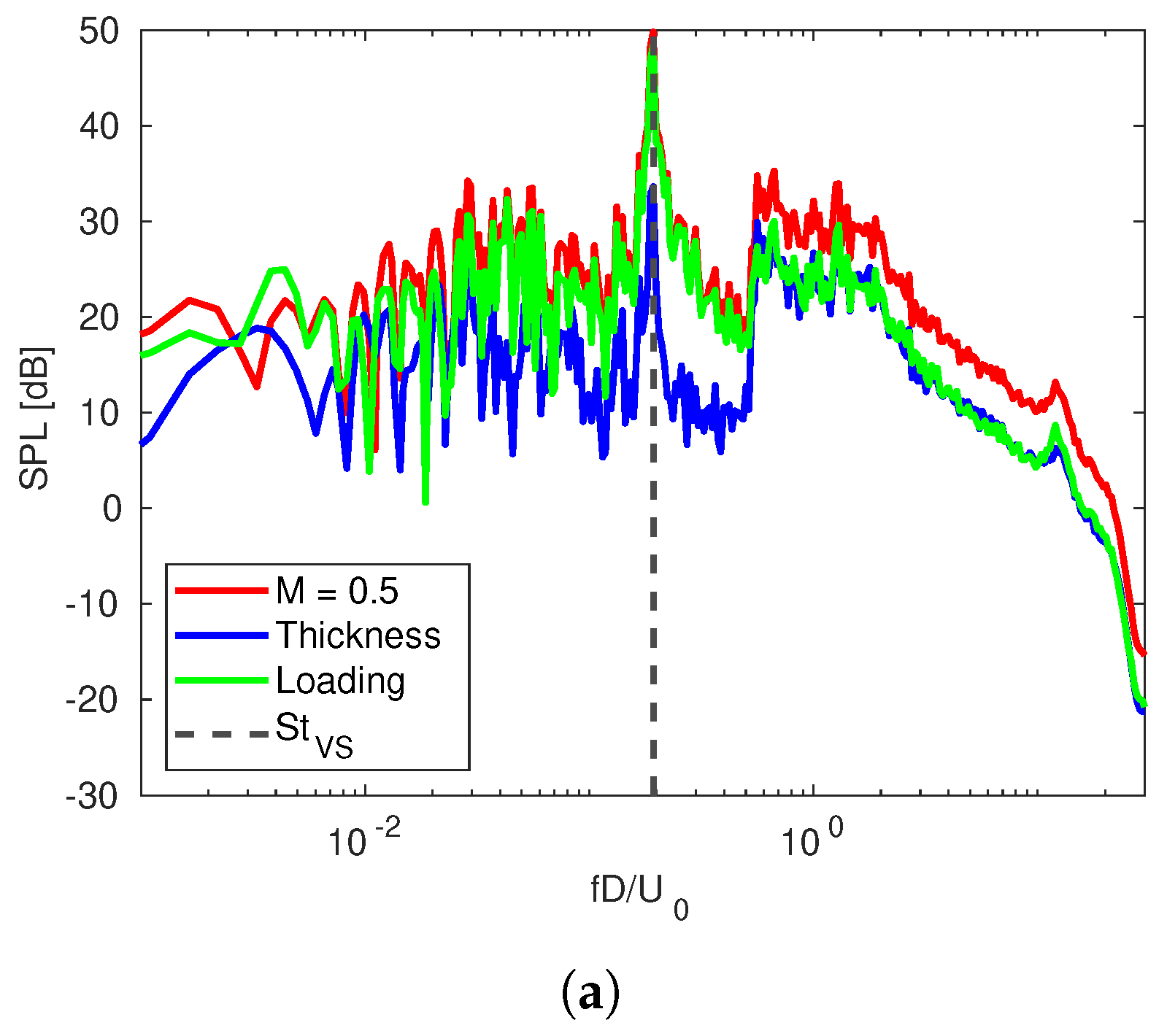
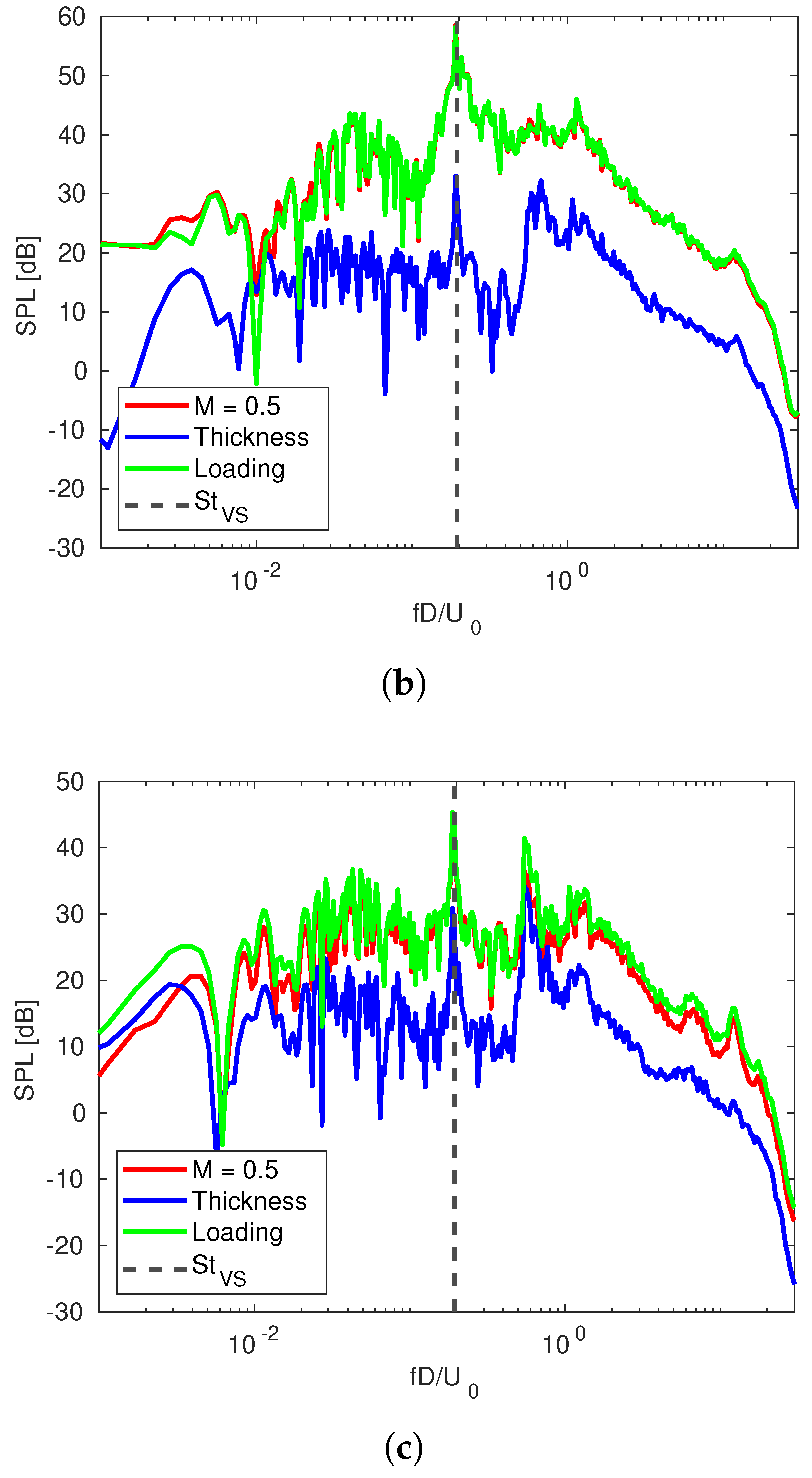
| Case | ||||
|---|---|---|---|---|
| Abrahamsen et al. (, LES) [64] | — | — | — | 0.712 |
| Dong and Karniadakis (, DNS) [63] | 0.203 | 1.143 | — | 0.820 |
| Wieselsberger (exp.) [68] | — | 1.143 | — | — |
| Gopalkrishnan (exp.) [69] | 0.193 | 1.186 | — | — |
| Norberg (, exp.) [70] | — | — | — | 1.022 |
| Norberg (, exp.) [62] | 0.202 | — | — | — |
| Khalighi et al. (, , LES) [24] | 0.192 | 1.290 | 0.630 | 0.680 |
| O. Rodríguez (, , exp.) [71] | — | 1.455 | — | — |
| Murthy and Rose (, , exp.) [67] | 0.183 | 1.430 | — | — |
| Present LES | 0.194 | 1.388 | 0.487 | 0.840 |
Disclaimer/Publisher’s Note: The statements, opinions and data contained in all publications are solely those of the individual author(s) and contributor(s) and not of MDPI and/or the editor(s). MDPI and/or the editor(s) disclaim responsibility for any injury to people or property resulting from any ideas, methods, instructions or products referred to in the content. |
© 2023 by the authors. Licensee MDPI, Basel, Switzerland. This article is an open access article distributed under the terms and conditions of the Creative Commons Attribution (CC BY) license (https://creativecommons.org/licenses/by/4.0/).
Share and Cite
Eiximeno, B.; Tur-Mongé, C.; Lehmkuhl, O.; Rodríguez, I. Hybrid Computation of the Aerodynamic Noise Radiated by the Wake of a Subsonic Cylinder. Fluids 2023, 8, 236. https://doi.org/10.3390/fluids8080236
Eiximeno B, Tur-Mongé C, Lehmkuhl O, Rodríguez I. Hybrid Computation of the Aerodynamic Noise Radiated by the Wake of a Subsonic Cylinder. Fluids. 2023; 8(8):236. https://doi.org/10.3390/fluids8080236
Chicago/Turabian StyleEiximeno, Benet, Carlos Tur-Mongé, Oriol Lehmkuhl, and Ivette Rodríguez. 2023. "Hybrid Computation of the Aerodynamic Noise Radiated by the Wake of a Subsonic Cylinder" Fluids 8, no. 8: 236. https://doi.org/10.3390/fluids8080236
APA StyleEiximeno, B., Tur-Mongé, C., Lehmkuhl, O., & Rodríguez, I. (2023). Hybrid Computation of the Aerodynamic Noise Radiated by the Wake of a Subsonic Cylinder. Fluids, 8(8), 236. https://doi.org/10.3390/fluids8080236









